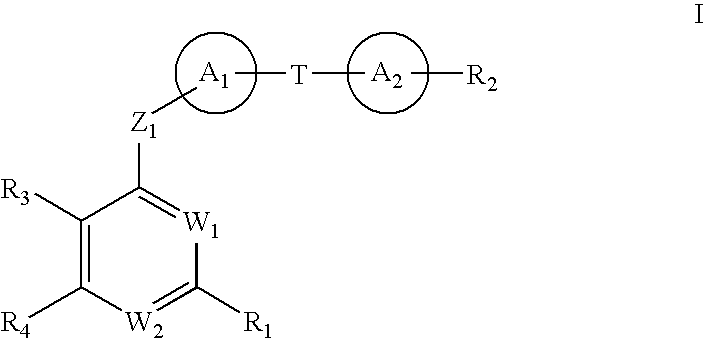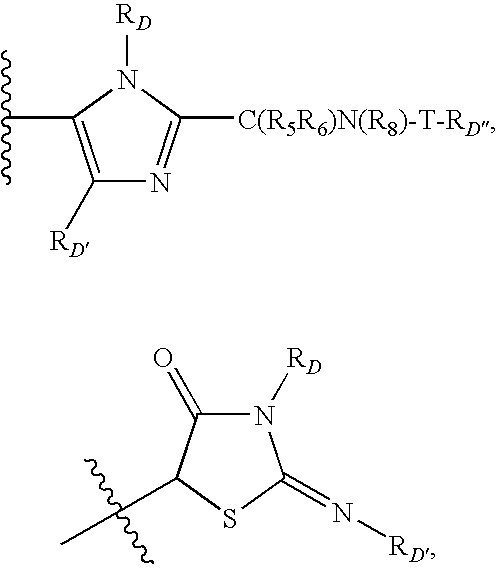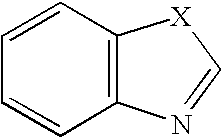Anti-Viral Compounds
a technology of antiviral compounds and compounds, applied in the field of antiviral compounds, can solve the problems of insufficient elimination of viral particles from the body, substantial limitations in efficacy and tolerability, etc., and achieve the effect of reducing the blood or tissue level of hcv virus
- Summary
- Abstract
- Description
- Claims
- Application Information
AI Technical Summary
Benefits of technology
Problems solved by technology
Method used
Image
Examples
example 1
S)-4-(4-aminophenylthio)-3-(7-isopropylpyrido[2,3-d]pyrimidin-4-ylamino)-N-(4-(2-(1-(2-phenylacetyl)pyrrolidin-2-yl)-1H-imidazol-4-yl)phenyl)benzamide
example 1a
4-(4-Amino-phenylsulfanyl)-3-nitro-benzoic acid methyl ester
A mixture of 4-chloro-3-nitrobenzoic acid methyl ester (15.0 g, 68 mmol), 4-aminothiophenol (8.8 g, 68 mmol) and K2CO3 (11.8 g, 85 mmol) in DMF (150 mL) was heated at 90° C. for 1.5 hours, cooled to room temperature, and then poured into H2O (450 mL) under stirring. The aqueous mixture was extracted with ethyl acetate (400 mL). The extract was washed with H2O (3 times) and brine, dried over MgSO4, and evaporated to give the crude product as orange crystal. The crude product was suspended in 150 mL of i-Pr2O and stirred at room temperature for 1 hour. The crystal was collected by filtration, washed with i-Pr2O and dried at 60° C. for 3 days under reduced pressure gave purified title compound as orange crystal (18.6 g, 90% yield).
example 1b
4-(4-tent-Butoxycarbonylamino-phenylsulfanyl)-3-nitro-benzoic acid methyl ester
A solution of the product from Example 1A (18.5 g, 61 mmol) and di-tert-butyl dicarbonate (26.8 g, 122 mmol) in p-dioxane (280 mL) was heated at 90° C. for 3 hours. An additional di-tert-butyl dicarbonate (26.8 g, 122 mmol) was added and the mixture was heated at 90° C. for 3 hours. A second additional di-tert-butyl dicarbonate (13.4 g, 61 mmol) was added and the mixture was heated at 90° C. for 4 hours. The reaction mixture was cooled to room temperature, and then evaporated. The residue was diluted with i-Pr2O (250 mL) and the mixture was stirred at room temperature for 1 hour. The resulting crystal was collected by filtration, washed with i-Pr2O and dried at 60° C. overnight under reduced pressure gave the title compound as yellow crystal (22.8 g, 93% yield).
PUM
| Property | Measurement | Unit |
|---|---|---|
| temperature | aaaaa | aaaaa |
| pH | aaaaa | aaaaa |
| RA LA | aaaaa | aaaaa |
Abstract
Description
Claims
Application Information
 Login to View More
Login to View More - R&D
- Intellectual Property
- Life Sciences
- Materials
- Tech Scout
- Unparalleled Data Quality
- Higher Quality Content
- 60% Fewer Hallucinations
Browse by: Latest US Patents, China's latest patents, Technical Efficacy Thesaurus, Application Domain, Technology Topic, Popular Technical Reports.
© 2025 PatSnap. All rights reserved.Legal|Privacy policy|Modern Slavery Act Transparency Statement|Sitemap|About US| Contact US: help@patsnap.com



